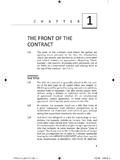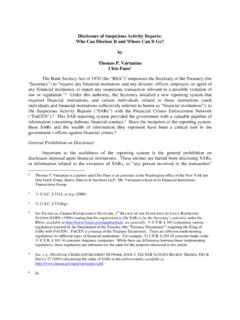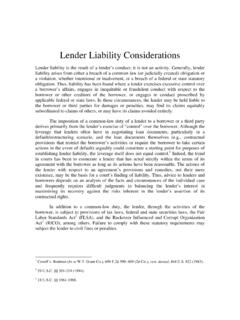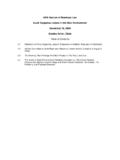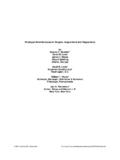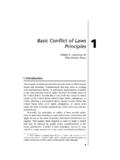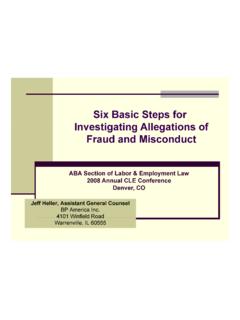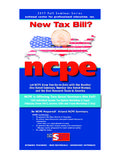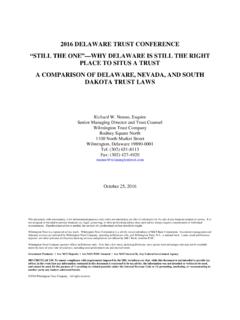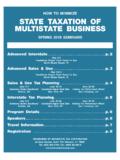Transcription of Accounting Principles and Concepts - American …
1 Accounting Principles and ConceptsSharon Z. Weiss, David East, Hartley, Damon, Carroll, CPAP resented to: American Bar AssociationApril 10, 20082 ObjectivesTo provide a basic understanding Key Accounting Concepts Financial statements (what are they?) Financial statement analysis techniques Regulatory governance Auditor reports Ratio analysis Putting financial statements to use Hot Topics ( , Sarbanes-Oxley)3 Key Accounting Concepts4 Accounting is the identification, measurement, and communication of financial information about economic entities to interested : Kieso, Donald E. and Jerry J. Weigandt, Intermediate Edition. 1995 NewYork: John Wiley & SonsAccountingWhat is Accounting ?5 AccountingKey ConceptsConservatismHistorical Cost BasisConsistencySubstance Over FormGoing ConcernMaterialityPeriodic ReportingAccrual Basis 6 AccountingElements to Accounting Systems ASSETSR esources with monetary value LIAIBILITIESC reditors claims on assets OWNERS EQUITYO wners and/or stockholders claims against assets REVENUESI ncome from sales and other sources EXPENSESC osts to company7 Financial Statements8 Financial Statements Definition The term financial statement refers to a presentation of financial data, including accompanying notes, derived from Accounting records and intended to communicate an entity s economic resources or obligations at a point in time or the changes therein for a period of time in conformity with a comprehensive basis of Accounting .
2 Source: AICPA Codification of Statements on Auditing Standards, AU 6239 Financial StatementsPrimary SEC Filings for Public CompaniesForm 10-K Contains annual financial statements Must be audited Other company disclosures and informationForm 10-Q Contains quarterly financial statements Must be reviewed, not to form an opinion, but to look for anomalies in the data Other company disclosures and information 10 Financial StatementsOverview of Financial StatementsFinancial Accounting Standards Board (FASB) states that a full set of financial statements should include: BALANCE SHEETF inancial position at the end of the period STATEMENT OF INCOMEI ncome for the period STATEMENT OF CASH FLOWSCash flows for the period STATEMENT OF CHANGES IN EQUITYI nvestments by and distributions to owners during the period FOOTNOTESA dequate disclosures to understand the financial statements11 Financial StatementsOverview of Financial StatementsBeginningBalance SheetJanuary 1 EndingBalance SheetDecember 31 Income Statementfor the Twelve Month PeriodStatement of Cash Flowsfor the Twelve Month Period12 Financial StatementsBalance SheetBalance Sheet ($ amts in thousands)12/31/2000 AssetsCurrent assets.
3 Cash$3,411 Marketable securities$2,333 Accounts Receivable, net$4,464 Inventories$2,842 Deferred taxes on income$1,151 Deposits and prepaid expenses$1,249 Total current assets$15,450 Marketable s ecurities$269 Property, plant, and equipment$6,971 Intangible as s ets$7,256 Deferred taxes on income$54 Other as s ets , net$1,321 Total assets$31,321 Liabilities and stockholders' equityCurrent liabilities: Accounts payable$2,083 Accrued liabilities$2,776 Loans and notes payable$1,479 Accrued salaries, wages and commissions$488 Taxes on incom e$314 Total current liabilities$7,140 Long-term debt$2,037 Deferred tax liability$255 Employee related obligations$1,753 Other liabilities$1,328 Total liab ilities$12,513 Stockholders' equity: Common stock and paid-in capital$1,535 Note receivable from stock ownership plan($35) Accumulated other comprehensive income($470) Retained earnings$18,812 Les s : com m on s tock held in treas ury($1,034) Total stockholders' equity$18,808 Total liabilities and stockholders' equity$31,321 Balance Sheet Objective: To provide reliable information about a company s economic resources and obligations A snapshot of financial position at a point in time Sometimes called the Statement of Financial PositionBalance Sheet Equation:Assets = Liabilities + OwnersAssets = Liabilities + Owners EquityEquity*See handout *See handout Balance Sheet ComponentsBalance Sheet Components for further further of Sales=Gross Profit-Operating Expenses=Operating Profit-FinancingExpenses-Tax Expense=Net Profit or (Loss)SalesGross profitO,F, & TexpensesCost of salesNet profitGross profitOperatingexpensesCost of salesO, F, & TexpensesNet lossSalesFinancial StatementsIncome Statement14 Financial StatementsIncome StatementIncome Statement ($ amts in thousands)12/31/00 Sales Revenue$29,139 Operating expenses.
4 Cost of goods sold($8,861) Gross Profit$20,278 Sales, marketing, and administrative expenses$10,875 Research expense$2,926In-process research & development$54 Interest income($379)Interest expense$146 Other expense, net$67 Restructuring charge($33)$13,656 Earnings before provision for taxes on income$6,622 Provision for taxes on income$1,822 Net earnings (income)$4,800 Earnings per share: Basic$ Diluted$ Statement Objective: To provide information about changes in net resources that result from business activities Reveals financial performance during a specific period of time For public companies, earnings per share will also be reported hereIncome Statement Equation:Revenues Revenues Expenses = Net IncomeExpenses = Net Income*See handout Income Statement Components for further StatementsIncome Statement$-$ $ $ $ $ per Share (EPS) Calculated by dividing Net Income (Earnings) by shares of common stock outstanding Small fluctuations in EPS may have a large impact on stock price16A Year in the Life of a Financial StatementHow Transactions Affect the Balance Sheet and Income StatementBalance SheetIncome StatementTOTAL ASSETSP roperty, Plant & EquipmentAccounts ReceivableInventoryCashASSETSTOTAL LIABILITIESLong-term DebtShort-term LoansAccounts PayableLIABILITIESTOTAL STOCKHOLDER EQUITYR etained EarningsPaid-in CapitalSTOCKHOLDER EQUITYPROFIT/(LOSS)SG&A ExpenseCost of Goods SoldRevenueINCOME STATEMENT as of JAN 1 TOTAL LIABILITIES + STOCKHOLDER EQUITYHow Do Balance Sheet and Income StatementReflect These Business a New Business, deposit cash into bank money to acquire property, equipment, the business (fixed expenses).
5 Sell products for cashHow Do Balance Sheet and Income StatementReflect These Business a New Business, deposit cash into bank money to acquire property, equipment, the business (fixed expenses); Sell products for cash17A Year in the Life of a Financial StatementHow Transactions Affect the Balance Sheet and Income StatementBalance SheetIncome StatementTOTAL ASSETSP roperty, Plant & EquipmentAccounts ReceivableInventoryCashASSETSTOTAL LIABILITIESLong-term DebtShort-term LoansAccounts PayableLIABILITIESTOTAL STOCKHOLDER EQUITYR etained EarningsPaid-in CapitalSTOCKHOLDER EQUITYPROFIT/(LOSS)SG&A ExpenseCost of Goods SoldRevenueINCOME STATEMENT as of JAN 1 TOTAL LIABILITIES + STOCKHOLDER EQUITY$1,000$1,000 Step 1 (Jan 1st): Startup Client Starts a New Business ( NewCo ) Deposits $1,000 cash into NewCo bank accountStep 1 (Jan 1st): Startup Client Starts a New Business ( NewCo ) Deposits $1,000 cash into NewCo bank account$1,000$1,000$1,000$1,00018 UPDATE INCOME STATEMENTUPDATE INCOME STATEMENTA Year in the Life of a Financial StatementHow Transactions Affect the Balance Sheet and Income StatementBalance SheetIncome StatementTOTAL ASSETSP roperty, Plant & EquipmentAccounts ReceivableInventoryCashASSETSTOTAL LIABILITIESLong-term DebtShort-term LoansAccounts PayableLIABILITIESTOTAL STOCKHOLDER EQUITYR etained EarningsPaid-in CapitalSTOCKHOLDER EQUITYPROFIT/(LOSS)
6 SG&A ExpenseCost of Goods SoldRevenueINCOME STATEMENT as of JAN 1 TOTAL LIABILITIES + STOCKHOLDER EQUITY$1,000$1,000$1,000 UPDATE TOTALSUPDATE TOTALS$0$1,000$1,000$0$0$0$0 THESE TOTALSSHOULD MATCH19A Year in the Life of a Financial StatementHow Transactions Affect the Balance Sheet and Income StatementBalance SheetIncome StatementTOTAL ASSETSP roperty, Plant & EquipmentAccounts ReceivableInventoryCashASSETSTOTAL LIABILITIESLong-term DebtShort-term LoansAccounts PayableLIABILITIESTOTAL STOCKHOLDER EQUITYR etained EarningsPaid-in CapitalSTOCKHOLDER EQUITYPROFIT/(LOSS)SG&A ExpenseCost of Goods SoldRevenueINCOME STATEMENTTOTAL LIABILITIES + STOCKHOLDER EQUITY$1,000$1,000$1,000$0$1,000$1,000$0 $0$0$0$5,000$4,000 Step 2: Setting Up Shop NewCo borrows $5,000 in long-term debt Spends $4,000 on property, plant, and equipment Spends $1,000 to purchase inventoryStep 2: Setting Up Shop NewCo borrows $5,000 in long-term debt Spends $4,000 on property, plant, and equipment Spends $1,000 to purchase inventory$4,000$4,000$5,000$5,000$1,000$ 1,000$1,00020A Year in the Life of a Financial StatementHow Transactions Affect the Balance Sheet and Income StatementBalance SheetIncome StatementTOTAL ASSETSP roperty, Plant & EquipmentAccounts ReceivableInventoryCashASSETSTOTAL LIABILITIESLong-term DebtShort-term LoansAccounts PayableLIABILITIESTOTAL STOCKHOLDER EQUITYR etained EarningsPaid-in CapitalSTOCKHOLDER EQUITYPROFIT/(LOSS)SG&A ExpenseCost of Goods SoldRevenueINCOME STATEMENTTOTAL LIABILITIES + STOCKHOLDER EQUITY$1,000$1,000$1,000$0$1,000$1,000$0 $0$0$0$5,000$4,000$1,000 UPDATE TOTALSUPDATE TOTALSTHESE TOTALSSHOULD MATCH$6,000$5,000$6,000 UPDATE INCOME STATEMENT(no change)UPDATE INCOME STATEMENT(no change)
7 21A Year in the Life of a Financial StatementHow Transactions Affect the Balance Sheet and Income StatementBalance SheetIncome StatementTOTAL ASSETSP roperty, Plant & EquipmentAccounts ReceivableInventoryCashASSETSTOTAL LIABILITIESLong-term DebtShort-term LoansAccounts PayableLIABILITIESTOTAL STOCKHOLDER EQUITYR etained EarningsPaid-in CapitalSTOCKHOLDER EQUITYPROFIT/(LOSS)SG&A ExpenseCost of Goods SoldRevenueINCOME STATEMENTTOTAL LIABILITIES + STOCKHOLDER EQUITY$1,000$1,000$1,000$500$200$200$100 $5,000$4,000$1,000$5,000$6,000$6,000 Step 3: Doing Business NewCo sells products totaling $500 Uses $200 in inventory (for goods sold) Spends $200 on operating expensesStep 3: Doing Business NewCo sells products totaling $500 Uses $200 in inventory (for goods sold) Spends $200 on operating expenses$200$200$500$500$200$200 UPDATE TOTALUPDATE TOTAL22A Year in the Life of a Financial StatementHow Transactions Affect the Balance Sheet and Income StatementBalance SheetIncome StatementTOTAL ASSETSP roperty, Plant & EquipmentAccounts ReceivableInventoryCashASSETSTOTAL LIABILITIESLong-term DebtShort-term LoansAccounts PayableLIABILITIESTOTAL STOCKHOLDER EQUITYR etained EarningsPaid-in CapitalSTOCKHOLDER EQUITYPROFIT/(LOSS)SG&A ExpenseCost of Goods SoldRevenueINCOME STATEMENTTOTAL LIABILITIES + STOCKHOLDER EQUITY$1,000$1,000$1,000$500$200$200$100 $5,000$4,000$1,000$5,000$6,000$6,000 UPDATE BALANCE SHEET CASH CHANGE: Revenue Operating Expense = Change ($500 $200) = $300 Increase INVENTORY CHANGE: $200 Decrease RETAINED EARNINGS: $100 ProfitUPDATE BALANCE SHEET CASH CHANGE.
8 Revenue Operating Expense = Change ($500 $200) = $300 Increase INVENTORY CHANGE: $200 Decrease RETAINED EARNINGS: $100 Profit$300$300$200$200$100$100$1,300$800 $10023A Year in the Life of a Financial StatementHow Transactions Affect the Balance Sheet and Income StatementBalance SheetIncome StatementTOTAL ASSETSP roperty, Plant & EquipmentAccounts ReceivableInventoryCashASSETSTOTAL LIABILITIESLong-term DebtShort-term LoansAccounts PayableLIABILITIESTOTAL STOCKHOLDER EQUITYR etained EarningsPaid-in CapitalSTOCKHOLDER EQUITYPROFIT/(LOSS)SG&A ExpenseCost of Goods SoldRevenueINCOME STATEMENT as of Dec. 31 TOTAL LIABILITIES + STOCKHOLDER EQUITY$1,000$1,000$500$200$200$100$5,000 $4,000$5,000$6,000$6,000$1,300$800$100 UPDATE TOTALSUPDATE TOTALSTHESE TOTALSSHOULD MATCH$6,100$1,100$6,10024 BEGINNING CASHENDING CASHF inancial StatementsStatement of Cash Flows25 Financial StatementsStatement of Cash Flows Statement of Cash Flows ($ amts in thousands)12/31/00 OperationsNet earnings$ 4,800 Depreciation and amortization1,515 In-process research and development54 Increase in deferred taxes(167) Accounts receivable reserves33 Increase in accounts receivable(451) Decrease (increase) in inventories125 Accounts payable and accrued liabilities57 Decrease in other current and non-current assets143 Increase in other current and non-current liabilities454 Net cash from operations6,563 InvestingAdditions to property, plant, and equipment(1,646)Proceeds from the disposal of assets161 Acquisition of businesses, net of cash acquired(68)
9 Purchases of investments(5,383)Sales of investments4,670 Other(102) Net cash used for investing(2,368)FinancingDividends to shareholders(1,724)Repurchase of common stock(973)Proceeds from short-term debt814 Retirement of short-term debt(1,485)Proceeds from long-term debt4 Retirement of long-term debt(28)Proceeds from the exercise of stock options292 Net cash used for financing(3,100)Net change in cash and equivalents1,095 Objective: To classify and report cash receipts and Sections: Operating. Discloses the inflows and outflows of cash due to operations Investing. Discloses the inflows and outflows of cash due to the purchase and sales of PP&E and other investment instruments Financing. Discloses the inflows and outflows of cash due to the retirement and receipt of debt26 Financial StatementsFootnotesFootnotes disclose financial information not contained in the basic financial statements but still required by GAAPC ommon Disclosures: Accounting policies and methods Description of financial risks Significant management judgments Lawsuits/Contingencies Related party activity Income taxes Obligation terms Employee benefit plans Subsequent eventsFootnotes are necessary to fully understand the Financial Statements27 Regulatory & Auditor Reports28 RegulatoryWho Sets The Rules?
10 Financial Reporting & Disclosure Financial Accounting Standards Board (FASB) Securities and Exchange Commission (SEC)Auditing & Professional Standards Before Sarbanes-Oxley Act (2002): American Institute of Certified Public Accountants (AICPA) Now: Public Company Accounting Oversight Board (PCAOB)for public companies and AICPA for private companies29 Auditor ReportsTypes of Auditor ReportsReview4 Limited Assurance4 Analytical Procedures and Inquiries of ManagementCompilation4No Assurance4 Compiles Financial Information into Financial StatementsAgreed-upon procedures4 Provides limited assurance with respect to specific areas tested4 Distribution of the report is restricted to those specified users4No opinions30 Auditor ReportsTypes of Auditor ReportsAudit4 Positive assurance4 Now includes separate report on internal controls4 Types of Audit Opinions: Unqualified Opinion Qualified Opiniono Scope Limitati

